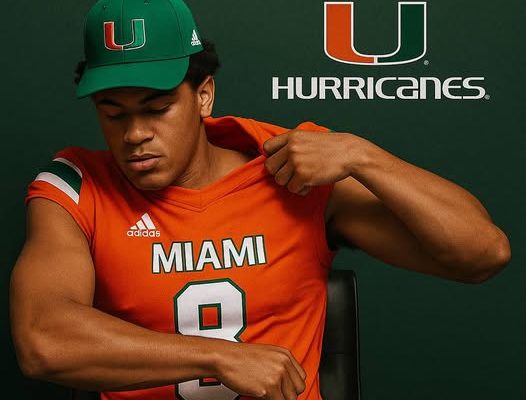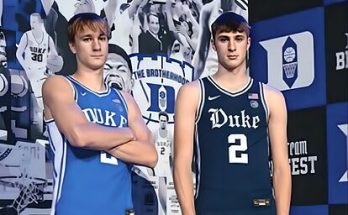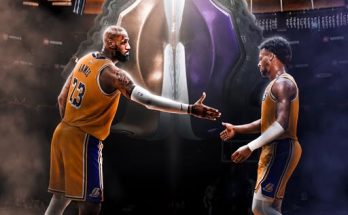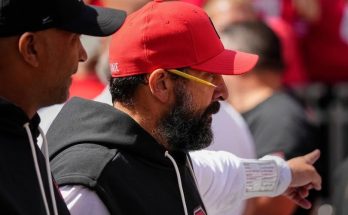Just in: Here we go — official! 280-pound powerhouse quarterback Eli Stowers has flipped his commitment to the Miami Hurricanes in a stunning twist that shakes the foundation of the 2026 recruiting landscape. The announcement sent shockwaves through the college football world, as Stowers had long been thought to be locked in with his prior commitment. Now, with his allegiance turned southward toward Coral Gables, the Hurricanes have scored one of the most pivotal recruiting victories in recent memory — one that not only redefines their quarterback room, but also reshapes the national recruiting narrative leading into 2026.
Eli Stowers isn’t just another top quarterback prospect. He’s a unique and imposing figure who stands out immediately on any field — not only because of his staggering 6-foot-5, 280-pound frame, but because of his raw athleticism, violent arm strength, and uncanny ability to extend plays in ways that feel more like a modern-day Cam Newton with shades of Ben Roethlisberger’s pocket toughness. Originally committed to a major SEC program — whose name is being left unspoken by both parties following his announcement — Stowers’ decision to decommit and pivot to Miami marks a definitive statement of intent. He isn’t merely going to play college football. He’s aiming to leave a legacy.
For the Miami Hurricanes, this is more than a five-star coup. This is a declaration. It signals that under Mario Cristobal, the program is not only targeting elite-level recruits but successfully executing on their vision. Miami has been hunting for a transcendent quarterback to lead their resurgence, someone who can handle the pressure of the spotlight and lead a renaissance in South Florida football. With Stowers, they may have found exactly that player — and potentially more.
What makes Stowers so intriguing is the sheer dynamism he brings to the position. While quarterbacks with mobility and arm talent are increasingly common in today’s game, few combine that skillset with the physicality of a defensive end and the mental fortitude of a seasoned leader. Stowers is the type of athlete who could have played on either side of the ball if he had chosen to. That he’s playing quarterback, and playing it at such an elite level, is part of what makes his ceiling so astronomical. He not only commands an offense — he imposes his will on defenders. Defensive backs bounce off him. Linebackers struggle to corral him. Pass rushers get frustrated when they arrive and can’t bring him down.
His flip to Miami is the product of months of subtle shifts, back-channel conversations, and calculated evaluation by the Hurricanes staff. What started as mutual interest escalated into something deeper when Stowers made an unofficial visit this past spring. Sources close to the program noted that the visit was different — not just because of the facilities or the coaching pitch, but because of the energy Stowers felt. He saw something in Miami’s vision for the future that clicked. The program didn’t just want him to be part of a good recruiting class. They wanted him to be the centerpiece — the cornerstone.
Recruiting insiders began to suspect a potential shift when Stowers postponed several scheduled media appearances with the school he was originally committed to, and when his social media activity started showing subtle but unmistakable ties to the Hurricanes’ ecosystem. While he remained silent publicly, Miami’s confidence behind the scenes began to rise. When the flip was officially announced, it confirmed the whispers that had been growing louder over the past few weeks — that something seismic was happening in Coral Gables.
For fans of the Hurricanes, this is a moment to savor. It’s not just about landing a five-star quarterback. It’s about changing perception. Miami has long carried the weight of its illustrious past, with multiple national championships, NFL legends, and one of the most iconic brands in all of sports. But the last two decades have seen the program stumble through coaching changes, recruiting inconsistencies, and an identity crisis. With Cristobal at the helm and now Stowers on board, there is a growing belief that the Hurricanes are finally returning to their roots — to a swagger built on elite talent, aggressive recruiting, and dominant football.
From a schematic standpoint, Stowers fits exactly what the modern game demands. His ability to run power-read concepts, extend plays with his legs, and fire 60-yard darts downfield gives Miami the kind of versatility that can stress even the best defenses. He is not just a dual-threat quarterback — he’s a multi-dimensional weapon. In red-zone situations, he becomes a nightmare to defend due to his physical size and short-yardage strength. In open field, he has surprising agility and enough speed to rip off 40-yard gains when the pocket collapses. And in the pocket, his improved mechanics and sharp football IQ allow him to process coverages and read progressions like a veteran.
Coaches who have worked with Stowers have consistently praised his work ethic and commitment to development. He’s not content to rely on his physical gifts. He’s put in the hours to study film, perfect his release, and become a vocal leader in every locker room he’s been part of. At the high school level, he was known as a coach on the field — someone who could rally teammates, adjust protection calls, and command the respect of both his offense and defense.
What’s especially fascinating about his flip is the broader context of quarterback recruiting in the 2026 cycle. The class is loaded with talent, and several blue-blood programs believed they had locked in their guy. But Stowers’ decision creates a ripple effect that could realign commitments, flip dominoes, and throw recruiting boards across the country into chaos. Programs that missed on him may scramble to re-engage with their secondary targets, while others may start pursuing late-emerging prospects. Miami, for their part, has gone from being a program looking for answers at quarterback to a program that has the most physically imposing QB commit in the country — possibly the most impactful single offensive commitment in this entire class.
Beyond recruiting, this commitment signals that Miami is again a destination. In the NIL era, with high-level athletes looking for a mix of exposure, branding, and development, the Hurricanes offer all of it. South Florida is a football hotbed, and the ability for a high-profile player like Stowers to step into that environment and own the moment is part of what makes this pairing so electric. Already, the buzz surrounding his arrival is palpable — from fans designing mock jersey edits to teammates in the 2026 class trying to join him in Coral Gables.
This is a player who will immediately bring eyes, hype, and scrutiny. But for someone like Eli Stowers, pressure is not an obstacle — it’s the fuel. In interviews over the last year, he’s spoken about the desire to play for a program where he can make a real difference. Miami now becomes that proving ground. The path is set, the lights are bright, and the expectations are high.
One of the biggest questions now is how quickly Stowers can galvanize others to follow. Elite wide receivers, offensive linemen, and even defensive standouts may see his commitment as a sign that Miami is serious about building a contender. It’s no coincidence that within minutes of his flip being announced, multiple four-star and five-star prospects began retweeting and posting “” emojis in reaction. He has pull — not just because of who he is, but because of what he represents: a belief that something special is building in Miami.
For all the talk of quarterbacks and five-star flips, this is ultimately a story of fit — the right player at the right time for the right program. Eli Stowers’ flip to Miami is not just a news headline. It’s a landmark moment that will be remembered when college football historians look back at the start of Miami’s new era. He is the hurricane within the Hurricanes, a force of nature ready to uproot expectations, rattle the national order, and restore the throne to South Florida.



